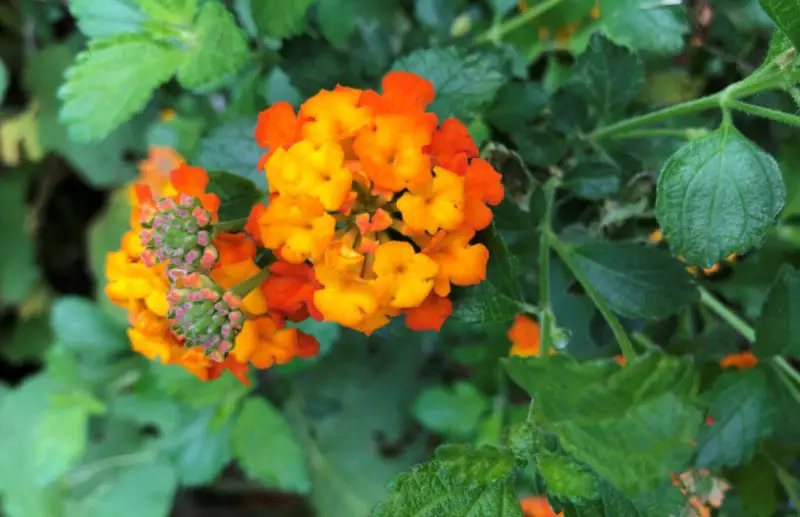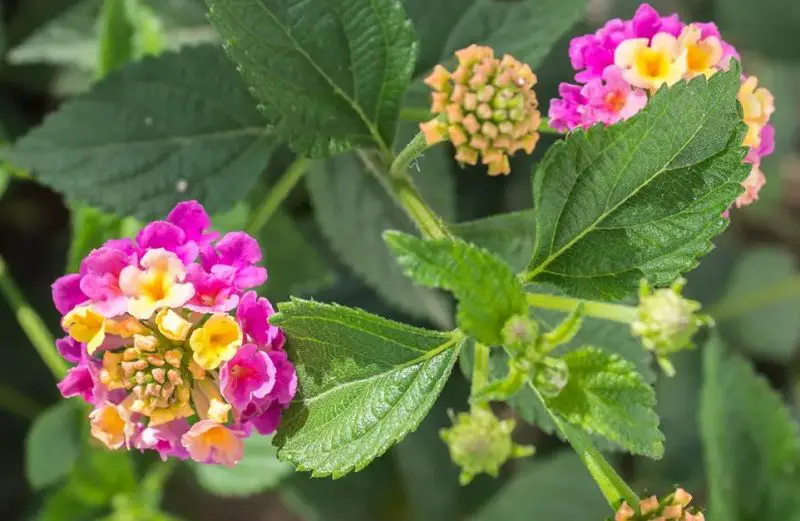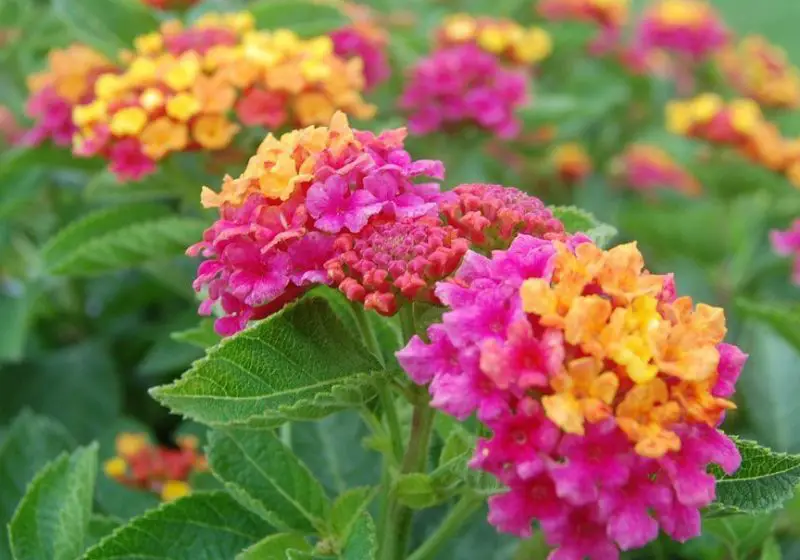With its vibrant blooms and resilient nature, Texas lantana stands as a beloved addition to gardens and landscapes across various climates. As gardeners seek to cultivate this versatile plant, understanding its detailed care and growing requirements becomes paramount.
From soil preferences to pruning techniques, navigating the intricacies of Texas lantana cultivation ensures a thriving and picturesque display.
About Texas Lantana

Texas lantana, scientifically known as Lantana urticoides, is a resilient and versatile plant that thrives in various conditions. This deciduous shrub, also referred to as calico bush or West Indian shrub-verbena, is native to Texas and other parts of North America. Its adaptability is evident in its hardiness zones, ranging from USDA zones 8 to 11.
One of the most striking features of Texas lantana is its vibrant flowering display, which occurs from May through November. This extended blooming period adds bursts of color to gardens and landscapes for much of the year. With its ease of cultivation, this plant is a favorite among gardeners, regardless of their level of experience.
Texas lantana is particularly well-suited to sunny locations and thrives in hot, dry conditions. Its water needs are minimal, requiring watering only once a week. Additionally, it prefers poor, well-drained soil with slightly acidic pH levels ranging from 5.5 to 6.5. This plant does not demand feeding, further simplifying maintenance tasks.
In terms of size, Texas lantana typically grows to heights between 2 to 6 feet, spreading out equally wide. Its growth expectations make it a versatile choice for various landscaping needs, from ground cover to border plants.
While Texas lantana offers numerous benefits, it’s essential to be aware of its toxicity. The berries of this plant are toxic to humans, pets, and livestock if ingested. Moreover, contact with the foliage may cause skin rash, necessitating cautious handling.
Overall, Texas lantana stands out as a resilient, low-maintenance option for gardeners seeking a pop of color and texture in their outdoor spaces. Its adaptability, extended flowering season, and minimal care requirements make it a valuable addition to any garden or landscape design.
How to Grow and Care for Texas Lantana

Light
Light preferences are crucial for the optimal growth of Texas lantana. This resilient plant thrives when exposed to full sun, requiring a minimum of 7 to 8 hours of direct sunlight daily. Adequate sunlight ensures vigorous growth and prolific flowering, making it essential to position Texas lantana in locations where it can receive ample sunshine throughout the day. With its preference for full sun exposure, this plant adds vibrant colors and texture to gardens and landscapes, enhancing the beauty of outdoor spaces.
Soid
Ensuring proper soil conditions is essential for the successful cultivation of Texas lantana. Before planting, it’s advisable to assess soil drainage in the chosen location. Texas lantana requires a well-draining soil base to thrive. A practical method for testing soil drainage involves digging a 12-inch deep hole, approximately 8 to 12 inches wide, and filling it with water. Observing the drainage rate provides valuable insights into soil composition.
Once the water has drained for twelve hours, fill the hole again and keep an eye on the drainage duration. Soil that drains well should ideally discharge in three hours. Consider adding things like sand or vermiculite to the soil to improve drainage.
In terms of soil types, Texas lantana is suited for harsh locations since it tolerates very well-draining soil and exhibits resilience in less favorable soil conditions. With a pH range of 5.5 to 6.5, it grows best on soil that is acidic to mildly acidic.
Water
Watering practices play a crucial role in the care of Texas lantana, a plant that thrives in dry conditions and exhibits excellent drought tolerance. Generally, Texas lantana prefers minimal moisture, making it well-suited for landscapes with limited water availability. A deep watering session once a week is typically sufficient to sustain healthy growth and development.
Monitoring the plant’s foliage can offer valuable insights into its watering needs. If the leaves appear droopy or wilted, it may indicate a requirement for additional water. In such cases, providing a supplemental watering session can help rejuvenate the plant and restore its vitality.
Fertilizer
Fertilizing Texas lantanas requires a delicate balance, as these plants are considered light feeders. For those planted in the ground, applying a balanced fertilizer in early spring can provide a nutrient boost for optimal growth. However, it’s crucial to refrain from fertilizing within two months before the first frost date in your region to avoid stimulating new growth that may be vulnerable to cold damage.
When it comes to lantanas grown in containers, a different approach is necessary. These plants benefit from more frequent feeding, typically once per month. Using a water-soluble fertilizer at half-strength ensures a gentle yet effective nutrient supply for container-grown lantanas, supporting their health and vigor throughout the growing season.
Pruning Texas Lantana
Pruning Texas lantana is a beneficial practice that supports its overall health and appearance. Throughout the growing season, occasional shearing can stimulate flowering and encourage the emergence of fresh growth, enhancing the plant’s vitality and aesthetic appeal. It’s important to note that pruning activities should cease in the fall to avoid interfering with the plant’s natural dormancy process.
However, in late winter, an opportune time arises for more substantial pruning efforts. Gardeners can confidently cut back Texas lantana plants to the ground during this period, facilitating rejuvenation and preparing the plant for the upcoming growing season.
Propagating Texas Lantana
Propagating Texas lantana offers gardeners the opportunity to expand their plant collection and enhance their landscapes. There are several methods for propagation, each suited to different seasons and conditions.
During the winter dormancy period, root division proves effective. By carefully digging up the root ball and dividing it into smaller sections, gardeners can create new plants ready for growth when spring arrives. Additionally, clumps can be removed directly from the root ball while it’s still in the ground, providing another avenue for propagation during this time.
Throughout the growing season, propagation via cuttings is a viable option. Non-flowering greenwood shoots, typically 3 to 5 inches in length, can be selected and rooted in a well-draining medium, facilitating the growth of new plants.
For those interested in propagating Texas lantana from seeds, the process begins towards the end of winter. Collecting seeds from mature berries, gardeners can then plant them in a light-medium. With germination typically occurring within 40 to 60 days, seedlings can be transplanted into the garden when they reach a height of at least three inches, following the passing of the frost danger.
Furthermore, young nursery plants offer another avenue for propagation, as they can be transferred to garden plots in early spring, establishing themselves and contributing to the vibrant display of Texas lantana in the landscape. With these various propagation methods available, gardeners can enjoy the beauty and resilience of Texas lantana in abundance throughout their outdoor spaces.
Pests and disease problems
Texas lantana is renowned for its resilience and minimal maintenance requirements, making it a favorite among gardeners. Not only are these plants salt-tolerant and deer-resistant, but they also thrive in hot, dry conditions and exhibit impressive drought tolerance.
One notable advantage of Texas lantana is its resistance to common garden pests. Gardeners often find that these plants remain largely untouched by insect infestations, contributing to their hassle-free care. However, it’s essential to exercise caution when addressing pest issues. While insecticide soaps may be a go-to solution for some plants, they can prove detrimental to Texas lantana. Spraying lantana with insecticide soap can lead to the plant’s demise, emphasizing the importance of avoiding such treatments.
Texas Lantana Common Problems

Texas lantana is celebrated for its robustness and resilience, yet like any plant, it can encounter issues. Understanding these common problems is key to maintaining the health and vibrancy of Texas lantana in the garden.
One frequent issue gardeners may encounter is overwatering. Despite its drought tolerance, Texas lantana can suffer if subjected to excessive moisture. Overwatering can lead to root rot and other fungal diseases, compromising the plant’s overall health. Therefore, it’s crucial to adhere to a moderate watering schedule and ensure adequate soil drainage to prevent waterlogging.
Another challenge gardeners may face is nutrient deficiency. While Texas lantana is generally low-maintenance, it still requires essential nutrients for optimal growth and flowering. If the plant’s foliage starts to yellow or growth appears stunted, it may indicate a lack of nutrients in the soil. Applying a balanced fertilizer as needed can help address this issue and promote healthy growth.
Furthermore, despite its resistance to many pests, Texas lantana can occasionally attract unwanted visitors such as aphids or spider mites. While these pests may not pose a significant threat, their presence can affect the plant’s appearance and vitality.
Lastly, Texas lantana may experience damage from extreme weather conditions, particularly during periods of frost or prolonged drought. While the plant is resilient, severe weather events can still take a toll. Providing adequate protection during cold snaps and ensuring proper watering during dry spells can mitigate potential damage.






